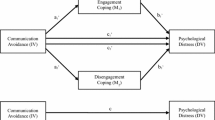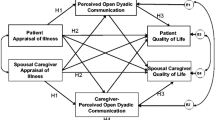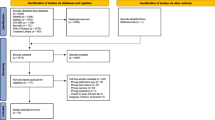Abstract
Introduction
The present study evaluated intimacy as a mechanism for the effects of relationship-enhancing (self-disclosure, mutual constructive communication) and relationship-compromising communication (holding back, mutual avoidance, and demand-withdraw communication) on couples’ psychological distress.
Methods
Seventy-five men diagnosed with localized prostate cancer in the past year and their partners completed surveys about communication, intimacy, and distress.
Results
Multi-level models with the couple as unit of analyses indicated that the association between mutual constructive communication, mutual avoidance, and patient demand-partner withdraw and distress could be accounted for by their influence on relationship intimacy. Intimacy did not mediate associations between self-disclosure, holding back, and partner demand-patient withdraw communication and distress.
Discussion/conclusions
These findings indicate that the way in which couples talk about cancer-related concerns as well as the degree to which one or both partners avoid talking about cancer-related concerns can either facilitate or reduce relationship intimacy, and that it is largely by this mechanism that these three communication strategies impact psychological distress.
Implications for cancer survivors
Relationship intimacy and how patients and partners communicate to achieve this intimacy is important for the psychological adjustment of early stage prostate cancer survivors and their partners.

Similar content being viewed by others
References
Balderson N, Towell T. The prevalence and predictors of psychological distress in men with prostate cancer who are seeking support. Br J Health Psychol. 2003;8:125–34.
Bisson JI, Chubb HL, Bennett S. The prevalence and predictors of psychological distress in patients with early localized prostate cancer. BJU International. 2002;90:56–61.
Cliff A, Macdonagh R. Psychosocial morbidity in prostate cancer: ll. A comparsion of patients and partners. BJU International. 2000;86:834–9.
Kornblith AB, Herr HW. Quality of life of patients with prostate cancer and their spouses. Cancer. 1994;73:2791–802.
Eton DT, Lepore SJ. Prostate cancer and health-related quality of life: a review of the literature. Psycho-Oncol. 2002;11(4):307–26.
Couper JW, Bloch S, Love A, Duchesne G, Macvean M, Kissane DW. The psychosocial impact of prostate cancer on patients and their partners. Med J Aust. 2006;185(8):428–32.
Street AF, Couper JW, Love AW, Bloch S, Kissane DW, Street BC. Psychosocial adaptation in female partners of men with prostate cancer. Eur J Cancer Care (Engl). 2009. Jul 20.
Badr H, Carmack Taylor CL. Sexual dysfunction and spousal communication in coupels coping with prostate cancer. Psych-Oncology. 2008. [Epub ahead of print].
Gray RE, Fitch M, Davis C, Phillips C. Interviews with men with prostate cancer about their self-help group experience. J Palliat Care. 1997;13(1):15–21.
Banthia R, Malcarne VL, Varni JW, Ko CM, Sadler GR, Greenbergs HL. The effects of dyadic strength and coping styles on psychological distress in couples faced with prostate cancer. J Behav Med. 2003;26(1):31–52.
Perez MA, Skinner EC, Meyerowitz BE. Sexuality and intimacy following radical prostatectomy: patient and partner perspectives. Health Psychol. 2002;21:288–93.
Boehmer U, Clark J. Communication about prostate cancer between men and their wives. J Fam Pract. 2001;50:226–31.
Garos S, Kluck A, Aronoff D. Prostate cancer patients and their partners: differences in satisfaction indices and psychological variables. (J Sex Marital Ther. 2007;4(5):1394–403. Epub 2007 Jul 18.
Lepore SJ, Helgeson VS. Social constraints, intrusive thoughts, and mental health after prostate cancer. J Soc Clin Psychol. 1998;17(1):89–106.
Kershaw TS, Mood DW, Newth G, Ronis DL, Sanda MG, Vaishampayan U, et al. Longitudinal analysis of a model to predict quality of life in prostate cancer patients and their spouses. Ann Behav Med. 2008;36(2):117–28.
Manne S, Badr H. Intimacy and relationship processes in couples' psychosocial adaptation to cancer. Cancer. 2008;112(S11):2541–55.
Manne SL, Ostroff J, Rini C, Fox K, Goldstein L, Grana G. The interpersonal process model of intimacy: the role of self-disclosure, partner disclosure and partner responsiveness in interactions between breast cancer patients and their partners. J Fam Psychol. 2004;18:589–99.
Porter L, Keefe F, Hurwitz H, Faber M. Disclosure between patients with gastrointestinal cancer and their spouses. Psycho-Oncol. 2005;14(12):1030–42.
Manne SL, Ostroff J, Norton T, Fox K, Goldstein L, Grana G. Cancer-related relationship communication in couples coping with early stage breast cancer. Psycho- Oncol. 2006;15(3):234–47.
Manne SL, Ostroff J, Winkel G, Grana G, Fox K. Partner unsupportive responses, avoidant coping, and distress among women with early stage breast cancer: patient and partner perspectives. Health Psychol. 2005;24(6):635–41.
Clark J, Bokhour B, Inui T, Silliman R, Talcott J. Measuring patient' perceptions of the outcomes of treatment for early prostate cancer. Med Care. 2003;41(8):923–36.
Lilleby W, Fossa SD, Waehre HR, Olsen DR. Long-term morbidity and quality of life in patients with localized prostate cancer undergoing definitive radiotherapy or radical prostatectomy. Int J Radiat Oncol Biol Phys. 1999;43(4):735–43.
Zubrod CG, Schneiderman M, Frei E, Brindley C, Gold G, Schnider B. Appriasal of methods for the study of chemotherapy of cancer in man: Comparative therapeutic trial of nitrogen mustard and triethylene thiophosphoramide. J Chronic Dis. 1960;11:17–33.
Rosen RC, Riley A, Wagner G, Osterloh IH, Kirkpatrick J, Mishra A. The international index of erectile function (IIEF): a multidimensional scale for assessment of erectile dysfunction. Urology. 1997;49(6):822–30.
Cappelleri JC, Rosen RC, Smith MD, Mishra A, Osterloh IH. Diagnostic evaluation of the erectile function domain of the international index of erectile function. Urology. 1999;54(2):346–51.
Litwin MS, Hays RD, Fink A, Ganz PA, Leake B, Brook RH. The UCLA prostate cancer index: development, reliability, and validity of a health-related quality of life measure. Med Care. 1998;36(7):1002–12.
Ishihara M, Suzuki H, Akakura K, Komiya A, Imamoto T, Tobe T, et al. Baseline health-related quality of life in the management of prostate cancer. Int J Urol. 2006;13(7):920–5.
Pistrang N, Barker C. The partner relationship in psychological response to breast cancer. Soc Sci Med. 1995;40:789–97.
Laurenceau JP, Barrett LF, Rovine M. The interpersonal process model of intimacy in marriage: a daily-diary and multilevel modeling approach. J Fam Psychol. 2005;19(2):314–23.
Christensen A, Sullaway M. Communication patterns questionnaire. Unpublished manuscript. Los Angeles: University of California; 1984.
Christensen A. Dysfunctional interaction patterns in couples. Perspectives on Marital Interaction. 1988;30–52.
Heavey CL, Layne C, Christensen A. Gender and conflict structure in marital interaction: a replication and extension. J Consult Clin Psychol. 1993;61(1):16–27.
Spanier GB, Filsinger EE. The dyadic adjustment scale. Marriage and family assessment: a sourcebood for family therapy. 1st ed. Beverly Hills: Sage; 1983. p. 155–68.
Schaefer MT, Olson DH. Assessing intimacy: the pair inventory. Journal of Marital and Family Therapy. 1981;47–60.
Talmadge L, Dabbs JM. Intimacy, conversational patterns, and concomitant cognitive/emotional processes in couples. J Soc Clin Psychol. 1990;9(4):473–88.
Derogatis L. BSI 18 administration, scoring and procedures manual. Minneapolis: NCS Pearson; 2001.
Kenny D, Kashy DA, Cook D. Dyadic data analysis. New York: Guilford; 2006.
Shrout PE, Bolger N. Mediation in experimental and nonexperimental studies: new procedures and recommendations. Psychol Meth. 2002;7(4):422–45.
Srivastava S, McGonigal KM, Richards JM, Butler EA, Gross JJ. Optimism in close relationships: how seeing things in a positive light makes them so. J Pers Soc Psychol. 2006;91(1):143–53.
Kurdek LA. The allocation of household labor by partners in gay and lesbian couples. J Fam Issues. 2007;28(1):132–48.
Baron R, Kenny D. The moderator-mediator variable distinction in social psychological research: Conceptual, strategic, and statistical considerations. J Pers Soc Psychol. 1986;51:1173–82.
Kenny DA, Korchmaros JD, Bolger N. Lower level mediation in multilevel models. Psychol Meth. 2003;8(2):115–28.
Manne SL, Ostroff J, Sherman M, Heyman R, Ross S, Fox K. Couples' support-related communication, psychological distress and relationship satisfaction among women with early stage breast cancer. J Consult Clin Psychol. 2004;72(4):660–70.
Berg CA, Wiebe DJ, Butner J, Bloor L, Bradstreet C, Upchurch R, et al. Collaborative coping and daily mood in couples dealing with prostate cancer. Psychol Aging. 2008;23(3):505–16.
Manne SL, Alfieri T, Taylor K, Dougherty J. Preferences for spousal support among individuals with cancer. J Appl Soc Psychol. 1999;29(4):722–49.
Finch J, Zautra A. Testing latent longitudinal models of social ties and depression among the elderly: A comparison of distribution-free and maximum likelihood estimates with nonnormal data. Psychol Aging. 1992;7(1):107–18.
Manne SL, Zautra AJ. Spouse criticism and support: their association with coping and psychological adjustment among women with rheumatoid arthritis. J Pers Soc Psychol. 1989;56:608–17.
Rosenthal R. Advanced social psychology. In: Tesser A, editor. Methodology. Boston: McGraw-Hill; 1995.
Schmitt N. Uses and abuses of coefficient alpha. Psychol Assess. 1996;8(4):350–3.
Northouse LL, Mood DW, Schafenacker A, Montie JE, Sandler HM, Forman JD, et al. Randomized clinical trial of a family intervention for prostate cancer patients and their spouses. Cancer. 2007;110(12):2809–18.
Canada AL, Neese LE, Sui D, Schover LR. Pilot intervention to enhance sexual rehabilitation for couples after treatment for localized prostate carcinoma. Cancer. 2005;104(12):2689–700.
Harden J, Northouse L, Cimprich B, Pohl JM, Liang J, Kershaw T. The influence of developmental life stage on quality of life in survivors of prostate cancer and their partners. J Cancer Surviv. 2008;2(2):84–94.
Kim Y, Kashy DA, Wellisch DK, Spillers RL, Kaw CK, Smith TG. Quality of life of couples dealing with cancer: dyadic and individual adjustment among breast and prostate cancer survivors and their spousal caregivers. Ann Behav Med. 2008;35(2):230–8.
Acknowledgements
This work was supported by an Established Investigator in Cancer Prevention and Control Award to Sharon Manne by the NCI (K05 CA109008), a Cancer Prevention and Control Career Development Award by the NCI (K07 CA124668) to Hoda Badr, a Memorial Sloan Kettering Society grant to David Kissane, and by a P30 CA006927 grant to Fox Chase Cancer Center. We would like to acknowledge the assistance of Drs. John Mulhall, Eric Horwitz, Richard Greenberg, David Chen, James Easton, Robert Uzzo, and Alan Pollack for allowing access to their patients for this study. Jennifer Burden, Megan Eisenberg, Kristen Sorice, and Sara Worhach collected study data. Maryann Krayger provided technical assistance.
Author information
Authors and Affiliations
Corresponding author
Rights and permissions
About this article
Cite this article
Manne, S., Badr, H., Zaider, T. et al. Cancer-related communication, relationship intimacy, and psychological distress among couples coping with localized prostate cancer. J Cancer Surviv 4, 74–85 (2010). https://doi.org/10.1007/s11764-009-0109-y
Received:
Accepted:
Published:
Issue Date:
DOI: https://doi.org/10.1007/s11764-009-0109-y




